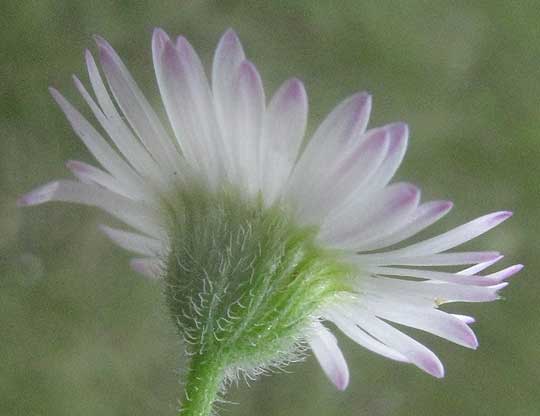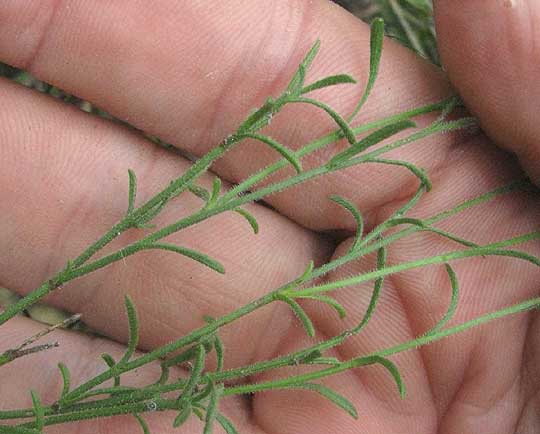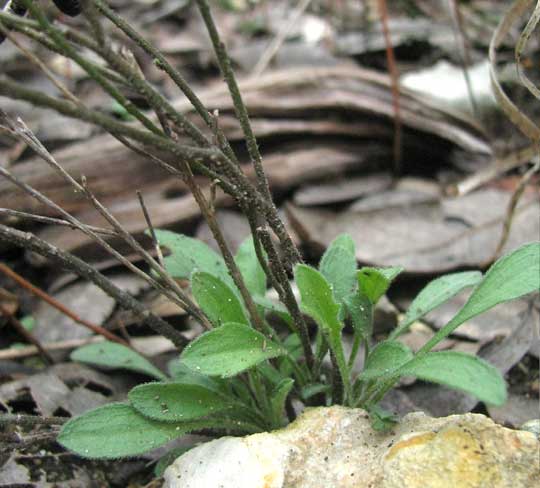Excerpts from Jim Conrad's
Naturalist Newsletter

from the October 20, 2013 Newsletter issued from the Frio Canyon Nature Education Center in the valley of the Dry Frio River in northern Uvalde County, southwestern Texas, on the southern border of the Edwards Plateau; elevation ~1750m (~5750 ft); N29.62°, W99.86°; USA
PLAINS FLEABANE
Here and there in grassy, open spots in the hillside woods surrounding Juniper House, as well as right beside Juniper House's back door, you see half-inch broad (13mm), daisy-type flowering heads on much-branched, slender-leafed, foot-tall stems such as those shown above.
Especially on dark, overcast or rainy days like some we've had this week, the white-rayed heads seem to hang suspended above other dark herbage. The daisy-type flower heads consist of white, petal-like ray flowers surrounding tiny, yellow, cylindrical disc flowers forming the "eye" in the heads' centers. A pretty shot of a flowering head from the top is shown below:

Most of the time when you see small daisy-type flowering heads like this with white rays and yellow discs, and both rays and discs are uncommonly slender, numerous and closely packed together, a good guess is that you're dealing with a fleabane -- a member of the genus Erigeron. Other genera share those features but fleabanes are very commonly encountered, and nearly 400 species are listed worldwide, and 173 are known from North America. So, even if you know you have a fleabane, if you want to know exactly who you have, you have to "do the botany."

Above, a view of the green involucre below the flowering head shows that the scale-like phyllaries are all about the same size, which is a little unusual, and they're very hairy, with the hairs not leaning close to the phyllaries' surface but rather loosely hanging outward -- all good field marks. Also important is that this species' hairy stems bear very narrow, small, hairy leaves, as shown below:

However, the stems arise from clusters of much broader leaves tufted at the stems' bases, as seen below:

One of the best field marks, however, needs to be seen with a good magnifying glass. That is, atop the future cypsela-type fruits formed by the disc flowers there are ten or so slender, white hairs constituting the pappus, but atop the ray flowers' cypselae, there are no hairs.
All these features lead us to the Plains Fleabane, ERIGERON MODESTUS, occurring in the US south-central states, from southwestern Kansas to Arizona and central Texas, south into arid, northeastern Mexico. The Flora of North America describes its preferred habitats as "rocky or gravelly sites, sand, clay, limestone, granite, sometimes deep sand, often with oak or oak-juniper, shrubland," so the grassy spots in our oak-juniper forest are good places for them.
The Plains Fleabane has a fascinating genetic makeup. The Flora of North America says that "Erigeron modestus is a polyploid complex apparently incorporating genes from E. flagellaris, E. tracyi, elements of E divergens, and the Mexican E. pubescens Kunth; arbitrary identifications may be necessary." A polyploid is an organism having one or more extra sets of chromosomes. Some estimates suggest that 30-80% of living plant species are polyploid, and many lineages show evidence of ancient polyploidy. Polyploidy happens in various ways. Wikipedia's page on it is at https://en.wikipedia.org/wiki/Polyploid.
The Flora also says that in Texas the Plains Fleabane is not "sympatric" with any of those species of which its genetic material consists -- sympatric meaning "found in the same place."
So, all those species shared genes with one another producing a whole new species that has been able to exploit habitats in a completely new part of the world.
The name "fleabane" suggests species that are the "banes," or "the curse", of fleas, though there's little or no evidence that fleabane upsets fleas at all.